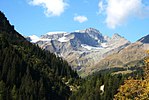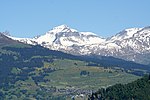Foo Pass

The Foo Pass (German: Foopass) is a mountain pass of the Glarus Alps, located on the border between the Swiss cantons of St. Gallen and Glarus, at an elevation of 2,223 m (7,293 ft). It crosses the col between the peaks of Foostock and Piz Sardona.The pass is traversed by a trail, which connects the village of Weisstannen, in the canton of St. Gallen at an elevation of 1,004 m (3,294 ft), with the village of Elm, in the canton of Glarus at an elevation of 977 m (3,205 ft). The trail forms part of the Alpine Pass Route, a long-distance hiking trail across Switzerland between Sargans and Montreux.The alpine pasture below the pass on the St Gallen side is notable for its marmot colony.
Excerpt from the Wikipedia article Foo Pass (License: CC BY-SA 3.0, Authors, Images).Foo Pass
Krauchtalstrasse, Glarus Süd
Geographical coordinates (GPS) Address Nearby Places Show on map
Geographical coordinates (GPS)
| Latitude | Longitude |
|---|---|
| N 46.942777777778 ° | E 9.2381944444444 ° |
Address
Foopass
Krauchtalstrasse
8766 Glarus Süd
Glarus, Switzerland
Open on Google Maps







